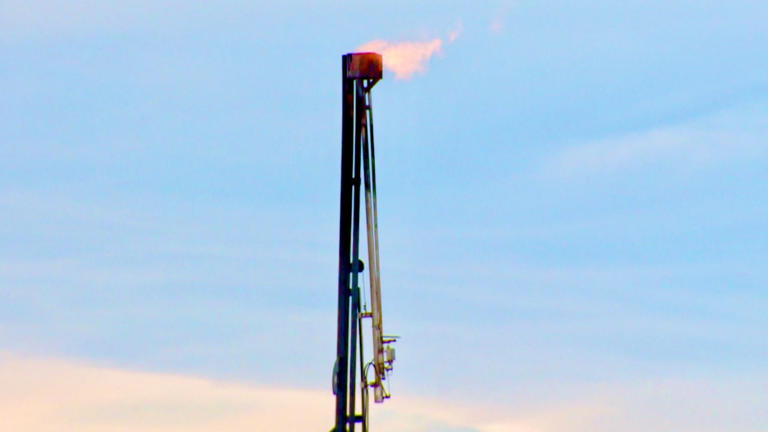Story by Kyle Bakx • CBC

Oil producers use flaring to burn methane gases, rather than release them directly into the atmosphere. Venting and flaring accounts for about 42 per cent of emissions in Saskatchewan, significantly higher than Alberta or B.C.
Producing a barrel of oil in Saskatchewan causes much higher emissions compared to the rest of Western Canada, and the province's emissions intensity is getting worse, according to data compiled by Enverus Intelligence Research.
An August report from the energy analytics firm focused on emissions intensity, which is a measure of greenhouse gas emissions that are released when producing a unit of oil and natural gas.
Since the beginning of 2021, the emissions intensity of Alberta and British Columbia has decreased, while it rose in Saskatchewan. Notably, the report also remarked on the overall slow rate of change in the three provinces.
"There was surprise around how flat the lines were on average, and also the uptick from Saskatchewan," said Ivana Petrich, a Calgary-based analyst with Enverus.
The increase in Saskatchewan's numbers is mainly due to its focus on the production of emissions-intensive heavy oil. In comparison, the emissions intensity of B.C.'s oilpatch is much lower because it's mainly focused on natural gas production.
One of the key challenges in Saskatchewan is venting and flaring.
When oil is pumped out of the ground, a certain amount of methane typically comes to the surface. Some companies capture those gases and transport them in a pipeline to be sold as natural gas. Other companies may release the gases into the atmosphere (venting) or burn them (flaring).
"If you were to compare the provinces, we see venting and flaring accounting for 42 per cent of emissions in Saskatchewan, compared to 15 per cent in Alberta and 13 per cent in B.C.," said Petrich.
Alberta's large existing network of natural gas pipelines helps to minimize the amount of venting and flaring that occurs. When a new well is drilled, a company may only have to build a short pipeline to connect to a main natural gas system.
But in Saskatchewan, a company may have to build a much longer — and more expensive — pipeline.
It's a well-known issue, according to Phil Tomlinson, an emissions engineer with Calgary-based Highwood Emissions Management, which helps industrial companies understand and reduce their emissions.
"In Saskatchewan, we don't have that [pipeline] infrastructure," he said. "It means that it's generally not economical."
Rather than venting methane gases, Saskatchewan oil producers should consider other options, like burning them or using them to heat nearby buildings, Tomlinson said.
Methane is considered to be 25 times as harmful to the atmosphere as carbon dioxide.
"You are better to burn off the methane than to vent it straight into the atmosphere," he said. "There are ways of destroying the methane with relatively high efficiency. It still produces CO2 but it produces less CO2 [compared to venting]."
Another factor impacting Saskatchewan's higher emissions intensity is that its oil wells are generally older than ones in Alberta, he added.
Smaller overall
Saskatchewan's oil industry is smaller than Alberta's energy industry, meaning its overall emissions are lower.
Since the start of the pandemic, Saskatchewan's total emissions have fallen but that's largely the result of a drop in oil production. The province's oilpatch emissions declined by about two per cent since the beginning of 2021, while oil and gas production has fallen by about 12 per cent, said Petrich.
Data used includes the production, transportation and processing of oil and natural gas. In Alberta, Enverus includes oilsands SAGD production but excludes oilsands mining.
Overall, total oilsands emissions were flat in 2022 even as production grew slightly, according to an August analysis released by S&P Global Commodity Insights.
In an emailed statement, Saskatchewan's energy department said its oil and gas emissions management regulations have "reduced greenhouse gas emissions (GHG) from reported venting and flaring by over 60 per cent below 2015 levels.
"This is significantly ahead of the previously announced goal of 40 to 45 per cent reduction in GHG reductions by 2025," said spokesperson Jacob Fergus.
The main oilpatch lobby group, the Canadian Association of Petroleum Producers, would not provide comment. The group instead pointed to its recent report that showed overall emissions in the conventional oil and gas sector declining over the last decade.
No comments:
Post a Comment